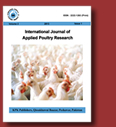|
|
|
|
|
|
|
|
Exploring the protective effect of silymarin against flutamide-induced
hepatotoxicity in male rats
|
|
Faried A. E. Hemieda, Mamdouh R. F. El-Sawi, El-Sayed K. Abdel-Hady and
Mona M. A. Alshabo |
|
Zoology Department, Faculty of Science, Mansoura University, Mansoura,
Egypt
|
| |
| Abstract |
|
The current study was designed to explore the protective impact of
silymarin (SIL) against the hepatotoxicity induced by daily
treatment with flutamide (FLU), for one month, in intact male rats. Two
different doses of FLU, one was low and corresponds to the human
therapeutic dose (10 mg/kg) and the other was high and corresponds to ½
lowest lethal dose (500 mg/kg) were applied. Obtained results showed
that oral administration of FLU in male rats significantly increased
hepatic malonic dialdehyde (MDA), and markedly decreased hepatic reduced
glutathione (GSH), superoxide dismutase (SOD), catalase (CAT),
glutathione peroxidase (GPx) and glutathione-s-transeferase (GST). In
parallel, activities of alanine aminotranseferase (ALT), aspartate
aminotranseferase (AST) and alkaline phosphatase (ALP), and level of
total bilirubin in serum were significantly elevated; while serum total
proteins, albumin and globulin, and hepatic total proteins were
decreased in FLU-treated animals. Also, significant increases in serum
and liver contents of total lipids (TL), total cholesterol (TC) and
triglycerides (TG), and serum low density lipoproteins-cholesterol
(LDL-c), which accompanied with decrease in serum level of high density
lipoproteins-cholesterol (HDL-c) following administration of FLU. The
adverse effects of FLU on measured parameters appeared to be
dose-dependent. Treatment with SIL (50 mg/kg) in rats given FLU (10 mg
or 500 mg/kg) greatly improved the levels of investigated biomarkers of
liver status. However, the beneficial effect of SIL was more remarkable
in rats receiving FLU at a dose of 10 mg/kg.
Obtained biochemical changes induced by the two used doses of FLU and
the ameliorative impact of SIL were confirmed by histopathological
examinations of
liver sections of treated rats.
In conclusion, SIL can be used effectively in the protection against
hepatotoxicity induced by FLU.
|
|
Keywords:
Flutamide; silymarin; hepatotoxicity; lipid peroxidation; antioxidants
hepatic markers |
| |
| To cite this article:
Hemieda FAE, MRF El-Sawi, El-Sayed K Abdel-Hady and MMA Alshabo,
2016.
Exploring the protective effect of silymarin against flutamide-induced
hepatotoxicity in male rats.
Res.
Opin. Anim. Vet. Sci., 6(8): 229-241. |
|
|

